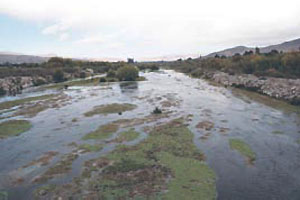Our territory, long and narrow, also modifies the river characteristics that run through it.
These watercourses are relatively shorts, flowing east westwards and are not apt for navigation. Also, they contain little water, but are fast-flowing, which enables to obtain electrical power from them.
We find rivers in the North of the country which nourishing regime is snowy (from or with snow), besides, most of them do not reach the sea, so this area is called endorheic.
There are some exceptions, such as Lluta and Loa that reach the littoral in impoverishing conditions. The Loa River possesses the most extended hydrographical river basin, reaching the 33.570 km2 and a length of 440 kilometres of its flow.
From the Loa River to the Copiapo River (Atacama Region) there are no courses of surface water, so that it belongs to an arreic zone. Great deal of the waters that filtrate easily in the soil, which makes it almost impossible to channel; however the underground shelters important water resources, lodged in subterraneous water layers.
Finally, from the Copiapó River southwards, we can find important surface river courses flowing into the sea. In the exoreic zone of our country we can find, north southwards, rivers such as Copiapo, Huasco, Elqui, Limari, Maipo, Rapel, Mataquito, Maule, Itata, Bio Bio, Imperial, Tolten, Palena, Cisnes, Baker y Pascua amongst others.
Food Regime
Accordingly to the food regime, we can find the existence of four types of rivers. Which are:
– Glacial: corresponds to those that nourish the snows and glaciers thawing: thus, presenting a sharp river rise during the springs and/or the summer, as a result of the thawing by effects of the solar radiation.
– Nival: its flow depends mainly of the snow amount accumulated during winter. As a difference with the glacial regime, its flow varies from year to year.
– Pluvial: the feeding of these rivers comes mainly from precipitations.
– Mixed: the flow has its origin in the overlapping of two regimes, thus we can distinguish rivers with a nivoglacial, novopluvial, pluvionival and pluvioglacial river regimes.








 Muere Evita
Muere Evita